Introduction to Product
In marketing, a product refers to anything a business offers customers to satisfy their needs or wants. A product can be a physical object, such as a car or a smartphone, or a service, such as insurance or consulting.
The concept of a product includes not only the physical characteristics of the item, but also its features, design, packaging, and branding. Product development involves identifying customer needs and developing new products or modifying existing ones to meet those needs.
Product management involves monitoring and analyzing the performance of products, including sales, profitability, and customer satisfaction. This helps businesses make informed decisions about pricing, promotion, and distribution. The product mix, or product portfolio, refers to the range of products a business offers its customers. This can include different product lines or variations within a product line. A well-managed product mix should meet the needs of various customer segments and be aligned with the overall marketing strategy of the business.

Different Levels of Product by Philip Kotler
Philip Kotler, a renowned marketing expert, introduced the concept of the “Levels of Product” in his book “Marketing Management.” The levels of product represent the different layers of a product offering that go beyond the physical attributes. According to Kotler, a product can be viewed at five different levels:
1. Core Product
The core product represents the fundamental benefit or solution that the customer is seeking when purchasing a product. It is the primary reason why a customer buys the product. For example, when someone buys a smartphone, the core product is the communication and connectivity it provides.
2. Generic Product
The generic product refers to the basic version of the product with no frills or additional features. It includes all the essential attributes necessary to fulfill the core product’s function. In the case of a smartphone, the generic product would include calling and texting features.
3. Expected Product
The expected product includes the attributes and traits that customers anticipate discovering within the product. These are the standard features that customers take into consideration. In the smartphone example, an expected product might include a camera, internet connectivity, and various apps.
4. Augmented Product
The augmented product includes additional features and enhancements that go beyond purchaser expectations and upload price to the product. These capabilities can be used to distinguish the product from competitors. In the case of a cellphone, augmented functions would possibly include a longer battery life, fingerprint recognition, or extra storage capability.
5. Potential Product
The potential product represents all of the viable upgrades and future innovations that may be delivered to the product to fulfill evolving customer desires. It includes future upgrades and advancements that the company may introduce. For a smartphone, potential product features might include 5G connectivity, enhanced AI capabilities, or holographic display technology.
Kotler’s Levels of Product concept highlights that successful marketing goes beyond the physical attributes of a product and focuses on fulfilling customer needs at various levels. By understanding and addressing each level, companies can better design, position, and market their products to meet customer expectations and achieve a competitive advantage.
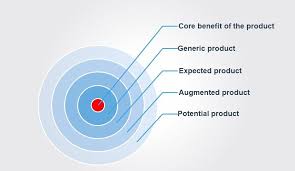
Types of Products
In marketing, products can be categorized into different types based on various factors such as customer behavior, purchase frequency, and intended use. The main types of products are:
1. Consumer Goods
Consumer goods are products purchased by individuals for personal use and satisfaction. They can be further classified into:
a) Convenience Products
These are inexpensive and frequently purchased items that customers buy with minimal effort. Examples include snacks, toiletries, and newspapers.
b) Shopping Products
Shopping products are more expensive and require more research and comparison before purchase. Examples include clothing, electronics, and furniture.
c) Specialty Products
Specialty products have unique characteristics or brand identification, and customers show strong brand loyalty to them. Examples consist of luxury vehicles, excessive-cease watches, and fashion designer apparel.
d) Unsought Products
Unsought products are merchandise that clients are not actively looking to buy. These products require aggressive marketing to generate demand. Examples include life insurance and funeral services.

2. Industrial Goods
Industrial goods are products used in the production of other goods or services by businesses and organizations. They can be further categorized into:
a) Raw Materials
Raw materials are unprocessed goods used in manufacturing. Examples include steel, wood, and petroleum.
b) Component Parts
Parts are manufactured goods that are incorporated into the final product. Examples include engines for vehicles or computer chips for electronics.
c) Capital Goods
Capital goods are long-lasting goods used to produce other goods or services. Examples include machinery, equipment, and buildings.
d) Supplies and Business Services
Supplies are consumable goods used in daily business operations, such as office supplies, while business services are intangible offerings like consulting or cleaning services.

3. Services
Services are intangible offerings that provide value to customers. They can be further classified into:
a) Professional Services
Professional services are specialized services by skilled people, which include legal, medical, and consulting services.
b) Retail Services
Retail offerings encompass services along with customer service, after-income service, and guarantees.
c) Hospitality Services
Hospitality offerings encompass offerings provided with the aid of the hospitality enterprise, including accommodations, eating places, and tourism-associated offerings.

4. Digital Products
Digital products are intangible products delivered electronically. They consist of software, e-books, digital tracks, and online guides.

5. Augmented Reality (AR) and Virtual Reality (VR) Products
These are merchandise that offers augmented reality or virtual fact studies, regularly used in gaming, schooling, or advertising.


6. Branded Products
Branded products are products that have a particular brand name and are associated with the logo’s identification and photograph.

7. Generic Products
Generic products are unbranded, basic variations of merchandise that can be generally cheaper and serve the same purpose as branded products.

These forms of merchandise cater to exceptional client desires and possibilities and require awesome advertising strategies to effectively reach their target audiences. Understanding the extraordinary product types allows businesses to tailor their advertising efforts and positioning to effectively meet purchaser demands and achieve enterprise goals.
Product Life Cycle
The product life cycle is an idea in advertising that describes the tiers a product goes through from its advent to its eventual decline and elimination from the marketplace. Understanding the product life cycle is essential for corporations to increase effective advertising strategies at each level. The typical product life cycle consists of four important levels:
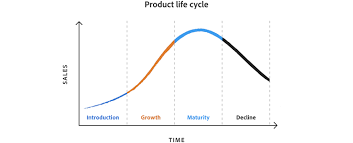
1. Introduction
The product is first introduced to the market at this phase of the product life cycle. During this phase, incomes are normally low as attention to the product continues to be cultivated among customers. Companies invest heavily in marketing and promotion to create product awareness and stimulate demand. Profits are usually minimal or negative due to high marketing and development costs.
2. Growth
In the growth stage, the product experiences a rapid increase in sales and customer acceptance. As consciousness spreads and good word-of-mouth builds, the product gains traction in the marketplace. Competitors may additionally enter the market at this stage, leading to extended opposition. Sales and profits rise during the growth stage, and the product becomes more profitable.
3. Maturity
During the maturity stage, the product reaches its peak level of sales and market saturation. Sales growth slows down as most potential customers have already adopted the product. The market becomes highly competitive, and price competition may intensify. Companies focus on product differentiation, cost reduction, and customer retention strategies to maintain market share and profitability.
4. Decline
In the decline stage, sales start to decline as the product faces saturation and obsolescence. Changing customer preferences, new technologies, or the introduction of superior products contribute to the decline. Companies may choose to discontinue the product, reduce marketing efforts, or target niche markets to extend the product’s life. Eventually, the product may be phased out of the market.
It’s critical to be aware that no longer all merchandise follows a traditional product existence cycle, and the duration of each degree can vary appreciably depending on the industry, opposition, and customer conduct. Additionally, some products might also revel in a couple of cycles, where they may be repositioned, rebranded, or undergo big updates to re-enter the boom phase.
Understanding the product lifestyle cycle allows businesses to make knowledgeable choices about product improvement, pricing, promotion, and distribution techniques at every level. It additionally publishes resource allocation and investment choices, helping companies adapt to changing market situations and customer needs at some point in the product’s life cycle.
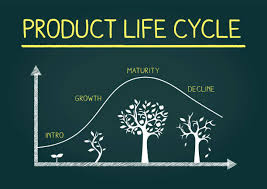
Features of Different Stages of the Product Life Cycle
The product life cycle consists of four distinct stages: introduction, growth, maturity, and decline. Each stage comes with its features and traits that impact product income, marketing strategies, and ordinary commercial enterprise decisions. Here are the important features of each level of the product existence cycle:
1. Introduction Stage:
a) Low Sales
Sales are initially low as the product is new to the market and awareness is limited.
b) High Marketing and Promotion Costs
Companies invest heavily in marketing and promotional activities to create product awareness and attract customers.
c) Limited Profitability
Profit margins are usually low or negative due to high initial development and marketing costs.
d) Technological and Design Development
During this stage, companies focus on refining the product and resolving any issues identified in the initial launch.
e) Limited Distribution
Distribution may be limited during the introduction stage as companies target specific regions or customer segments.
2. Growth Stage:
a) Rapid Sales Growth
Sales increase rapidly as more customers adopt the product and word-of-mouth spreads.
b) Increasing Market Share
Companies gain market share as the product gains popularity and competitors enter the market.
c) Lower Marketing Costs
As brand awareness grows, marketing expenses as a percentage of sales start to decline.
d) Improving Profitability
Higher sales volume and lower marketing costs lead to improved profitability.
e) Expansion of Distribution
Distribution channels expand to reach a broader customer base.
3. Maturity Stage:
a) Sales Plateau
Sales growth slows down as the product reaches market saturation and most potential customers have adopted it.
b) Intense Competition
Competition intensifies as multiple companies offer similar products, leading to price pressure.
c) Marketing Emphasizes Differentiation
Companies focus on product differentiation, brand loyalty, and customer retention strategies.
d) Stable Profitability
Profitability stabilizes as sales and marketing expenses level off.
e) Market Share Stabilization
Companies focus on maintaining their market share rather than aggressive growth.
4. Decline Stage:
a) Declining Sales
Sales start to decline as the product faces obsolescence or changing customer preferences.
b) Profitability Decline
With reduced sales, profit margins decrease, and profitability declines.
c) Streamlining Operations
Companies may reduce production and marketing efforts to cut costs.
d) Product Phasing Out
Some companies may choose to discontinue the product or remove it from the market.
e) Niche Markets
In some cases, the product may find niche markets or specialized uses to extend its life.
It’s important to be aware that the length of each stage can range substantially depending on the enterprise, product kind, and marketplace conditions. Companies want to continuously screen the product existence cycle and adapt their strategies for that reason to maximize sales, profitability, and market positioning at every level. A well-managed product life cycle can help businesses maintain competitiveness and sustain success in the marketplace.
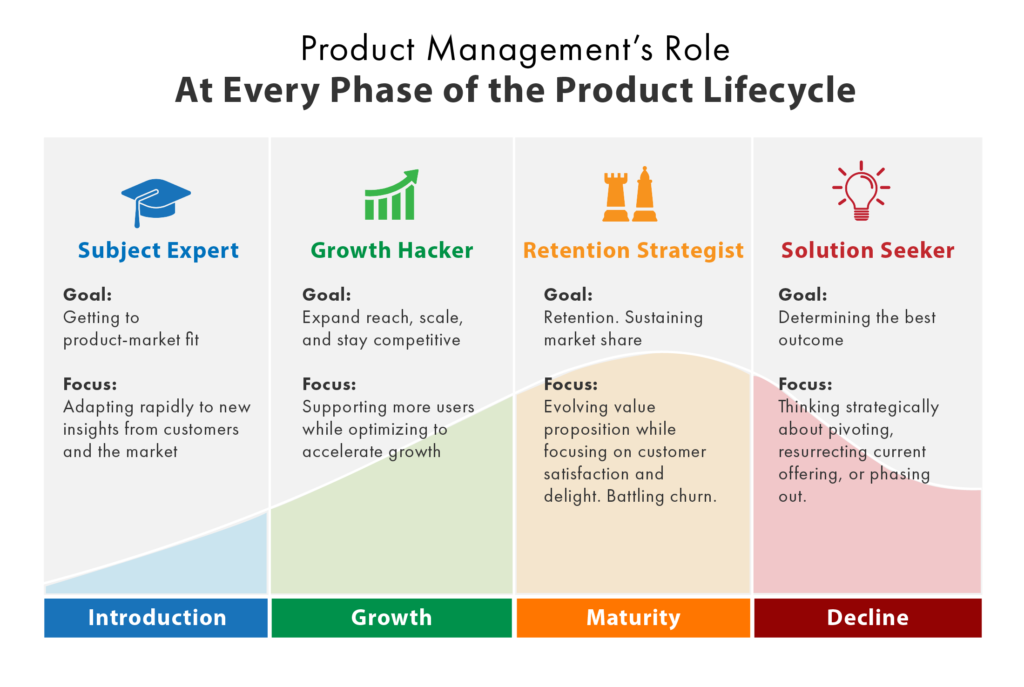
Product Positioning
Product positioning is a strategic marketing system that aims to set up a unique image and notion of a product in the minds of its target clients relative to competing products. This approach highlights the precise features, benefits, and cost proposition of the product, making it more attractive and unique within the target marketplace. Effective product positioning allows agencies to draw the proper customers and benefit from an aggressive advantage within the market.
The key elements of product positioning encompass:
1. Identifying the Target Market
The initial step in product positioning involves identifying the specific target market or customer segment the product intends to serve. Comprehending the requirements, inclinations, and attributes of the target clientele is essential when formulating a suitable positioning strategy.
2. Analyzing Competitors
Companies must assess their competitors and comprehend how their products are positioned in the market. This analysis identifies opportunities for differentiation, allowing the product to fill gaps in the market.
3. Unique Selling Proposition (USP)
The unique selling proposition is the fundamental message that distinguishes the product from competitors. It highlights the unique features, benefits, or value that the product offers, making it more attractive to customers.
4. Value Proposition
The value proposition communicates the overall value and benefits that the product provides to customers. It addresses specific needs or problems that the product solves and explains why it’s a superior choice compared to alternatives.
5. Positioning Statement
A positioning statement is a concise and clear message that communicates the product’s unique positioning. It often includes the target market, the product’s category, the distinct benefits, and the reasons why customers should choose the product.
6. Brand Image and Perception
Product positioning is closely intertwined with the overall brand image and perception. A consistent and coherent brand message reinforces the product’s positioning and aids in building brand equity.
7. Marketing Communication
The positioning strategy should be evident in all marketing communication, spanning advertising, packaging, promotional materials, and social media. Consistent messaging reinforces the desired perception among customers.
8. Customer Experience
The actual customer experience with the product significantly reinforces its positioning. Companies have to ensure that the product lives up to the promised blessings and meets client expectations.
9. Repositioning
Over time, marketplace dynamics may change, prompting the desire to reposition the product to stay applicable. Repositioning involves adjusting the product’s image or messaging to address changing customer needs or market conditions.
Effective product positioning facilitates an organization’s ability to attract its intended clients, boost sales, and build consumer loyalty. It lets businesses differentiate their products in an aggressive marketplace, cope with purchaser desires, and establish a strong market presence. By thoughtfully crafting the product’s picture and perception, organizations can gain a competitive edge and reap enduring achievement within the market.
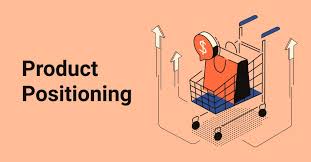
Features of Product Positioning
Product positioning involves creating a wonderful and favorable image of a product in the minds of the target customers. It encompasses various features that help differentiate the product from the competition and make it more attractive to the supposed target audience. Here are the key features of product positioning:
1. Unique Selling Proposition (USP)
The product’s unique selling proposition highlights its distinctive features, benefits, or attributes that set it apart from competing products. The USP answers the question, “What makes this product different and better?”
2. Target Market Focus
Product positioning identifies the specific target market or customer segment for which the product is designed. Understanding the target audience’s needs and preferences is essential for tailoring the product’s positioning message effectively.
3. Relevance to Customer Needs
Effective product positioning addresses the specific needs and pain points of the target customers. It demonstrates how the product provides a solution or fulfills a desire better than alternatives.
4. Competitive Differentiation
Product positioning emphasizes how the product stands out from competitors and positions itself favorably in comparison. It highlights the advantages that make the product a better choice.
5. Emotional Appeal
Product positioning can tap into customers’ emotions, values, or aspirations to create a deeper connection. Emotional appeal can strengthen brand loyalty and customer engagement.
6. Value Proposition
The value proposition communicates the overall value and benefits that customers can expect from the product. It demonstrates the return on investment or satisfaction customers will gain from choosing the product.
7. Perceptual Mapping
Perceptual mapping visually represents how customers perceive different products in the market. Product positioning aims to place the product strategically on this map to occupy a desirable position in customers’ minds.
8. Positioning Statement
A positioning statement is a concise statement that communicates the product’s unique positioning and value proposition. It provides a clear and consistent message to the target audience.
9. Brand Alignment
Product positioning aligns with the overall brand identity and brand promise. It reinforces the brand’s values, personality, and reputation.
10. Consistency Across Touchpoints
The product’s positioning should be consistent across all marketing touchpoints, including advertising, packaging, the website, social media, and customer service. This consistency reinforces the desired perception among customers.
11. Long-Term Focus
Product positioning is a long-term strategy aimed at establishing a sustainable and favorable image of the product in the market. It goes beyond short-term promotional campaigns.
12. Flexibility and Adaptability
Market dynamics change over time, and product positioning may need adjustments to remain relevant. Flexibility allows the positioning strategy to adapt to evolving customer needs and market trends.
13. Measurable Impact
Effective product positioning should result in measurable outcomes, consisting of extended brand focus, customer engagement, and sales growth.
Product positioning is a crucial aspect of the marketing approach, and its successful execution allows businesses to construct a robust brand, appeal to dependable clients, and acquire an aggressive advantage inside the marketplace. It calls for deep expertise in the target market and continuous tracking and refinement to remain effective over time.
Various Steps in Product Positioning
Product positioning involves a systematic process of creating a distinct and favorable image of a product in the minds of the target customers. The following are the various steps involved in product positioning:

1. Market Research
Conduct thorough market research to understand the target customers, their needs, preferences, and pain points. Identify the key competitors and analyze their positioning strategies.
2. Identify the Unique Selling Proposition (USP)
Determine the unique features, benefits, or attributes that set the product apart from competitors. This becomes the product’s USP.
3. Define Target Market
Clearly define the specific target market or customer segment for which the product is intended. Understand the demographics, psychographics, and behavior of the target audience.
4. Analyze Competitors
Evaluate the strengths and weaknesses of competitors’ products and their positioning strategies. Identify gaps in the market that the product can fill.
5. Develop a Positioning Strategy
Based on the USP, target market, and competitive analysis, develop a clear positioning strategy. Determine how the product will be positioned relative to competitors.
6. Create a Positioning Statement
Craft a concise and compelling positioning statement that communicates the product’s unique benefits, target market, and the reason customers should choose it over competitors.
7. Design Marketing Messages
Develop marketing messages that align with the positioning strategy. Messages should highlight the USP and resonate with the target audience’s needs and desires.
8. Choose Marketing Channels
Select the most appropriate marketing channels to reach the audience successfully. This may also include advertising, social media, content material advertising, and different promotional sports.
9. Implement the Positioning Strategy
Launch the product with the chosen positioning strategy and marketing messages. Ensure that all marketing efforts align with the intended positioning.
10. Monitor and Measure
Continuously monitor the effectiveness of the product positioning strategy. Use metrics such as brand awareness, customer feedback, and sales performance to measure success.
11. Gather Customer Feedback
Collect feedback from customers to understand how they perceive the product and its positioning. Use this feedback to make necessary adjustments if needed.
12. Repositioning (if necessary)
If market dynamics change or customer needs evolve, reevaluate the product’s positioning and be open to repositioning the product to remain relevant.
13. Consistency and Adaptability
Ensure consistency in positioning across all marketing efforts, but also be adaptable to respond to changing market conditions or customer feedback.
14. Long-Term Focus
Product positioning is a long-term strategy, so be patient and committed to building and maintaining the product’s desired image over time.
By following these steps, companies can effectively position their products in the market, differentiate them from competitors, and create a strong and positive perception among the target customers. Product positioning is an ongoing process that requires continuous monitoring and adjustments to stay relevant and successful in the ever-changing marketplace.
How do you Launch a Product in the Market?
Launching a product on the market requires careful planning, execution, and marketing efforts to ensure a successful introduction and a strong start. Here are the steps to effectively launch a product:
1. Market Research
Conduct thorough market research to understand the target market, customer needs, preferences, and competition. Identify the product’s unique selling proposition (USP) and its potential demand in the market.
2. Set Clear Objectives
Define clear and specific objectives for the product launch. Determine what you want to obtain, inclusive of income objectives, marketplace percentage, or brand consciousness.
3. Create a Launch Plan
Develop a complete launch plan that outlines the whole product launch process, together with key milestones, timelines, obligations, and advertising strategies.
4. Positioning and Messaging
Determine the product’s positioning in the market and craft compelling marketing messages that communicate its USP and value proposition.
5. Build Anticipation
Generate pre-launch buzz and anticipation among target customers through teaser campaigns, social media, and email marketing. Create excitement and curiosity about the upcoming product.
6. Prepare Marketing Collateral
Develop advertising materials, together with brochures, product movies, internet site content, and press releases, to aid the launch and communicate the product’s functions and advantages.
7. Sales and Distribution
Establish distribution channels and sales strategies to ensure the product is simply available to customers upon launch. Train sales teams on the product’s key features and selling points.
8. Price Strategy
Set an appropriate pricing strategy that aligns with the product’s value and positioning in the market. Consider competitive pricing, value-based pricing, or introductory gifts.
9. Testing and Quality Assurance
Conduct rigorous checking and a first-class guarantee to make certain the product meets customer expectations and is free from defects.
10. Soft Launch or Beta Testing
Consider a tender launch or beta checking out segment to accumulate remarks from a restricted organization of clients. Use this feedback to make any necessary improvements before the full launch.
11. Media and Public Relations
Engage with media and influencers to generate media coverage and positive reviews about the product. Leverage public relations to increase awareness and credibility.
12. Launch Event
Organize a release event to formally introduce the product to the market. Use the occasion as a possibility to show off the product’s capabilities and advantages and interaction with capable clients.
13. Monitor and Measure
Continuously monitor the product’s overall performance, patron feedback, and income statistics after the release. Use metrics to evaluate the success of the launch and make adjustments if needed.
14. Post-Launch Marketing
Continue marketing efforts beyond the launch to sustain momentum and drive ongoing sales. Consider offering promotions, special offers, or customer loyalty programs.
15. Customer Support
Provide excellent customer support to address any queries or issues customers may have after purchasing the product. Positive customer experiences contribute to long-term success.
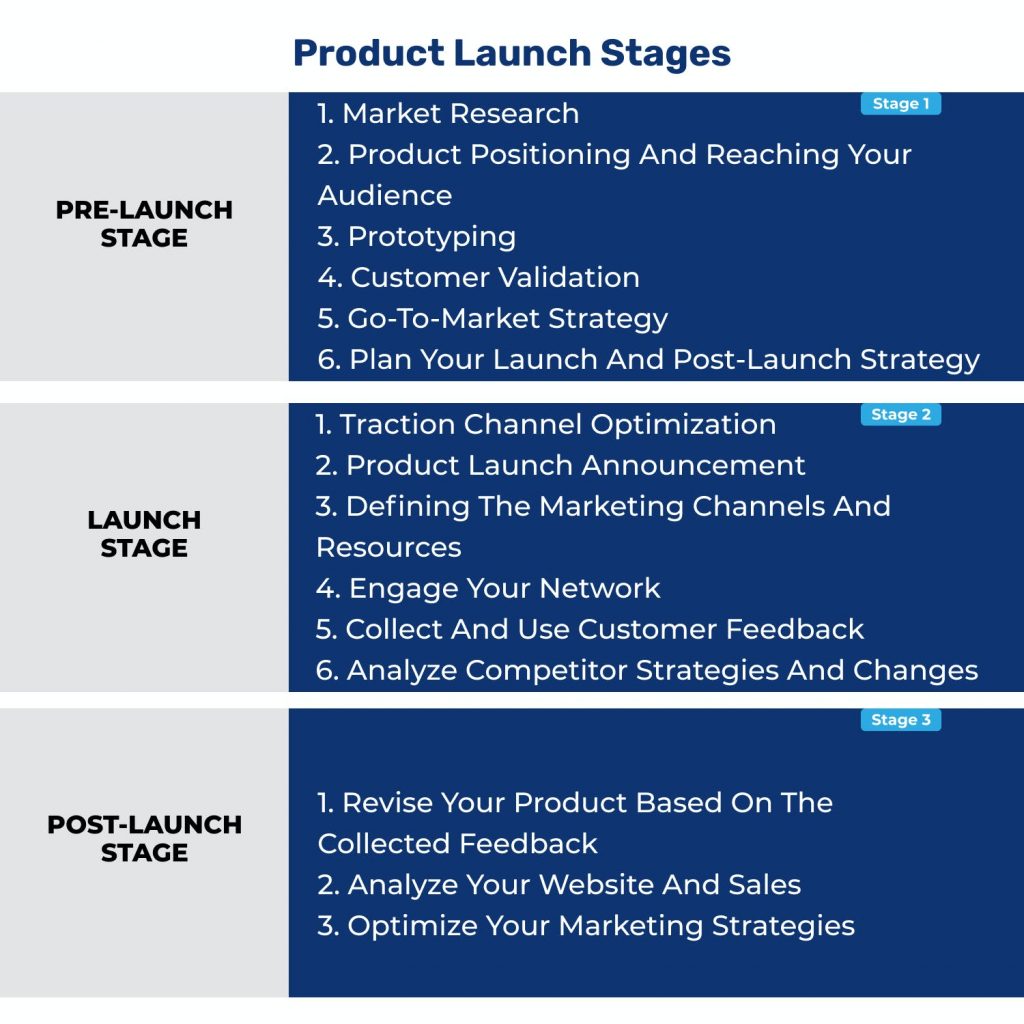
By following these steps and preserving a customer-centric approach, companies can correctly launch their products inside the marketplace, create a strong brand presence, and establish a solid foundation for destiny boom and fulfillment.




[…] ongoing success. It’s a shining example of how blending user participation with exceptional product features can create a marketing […]